Documenting equipment losses from the 2023 Wagner mutiny
The DFRLab revisits Yevgeny Prigozhin’s failed insurrection against the Russian military, six months ago this week
Documenting equipment losses from the 2023 Wagner mutiny
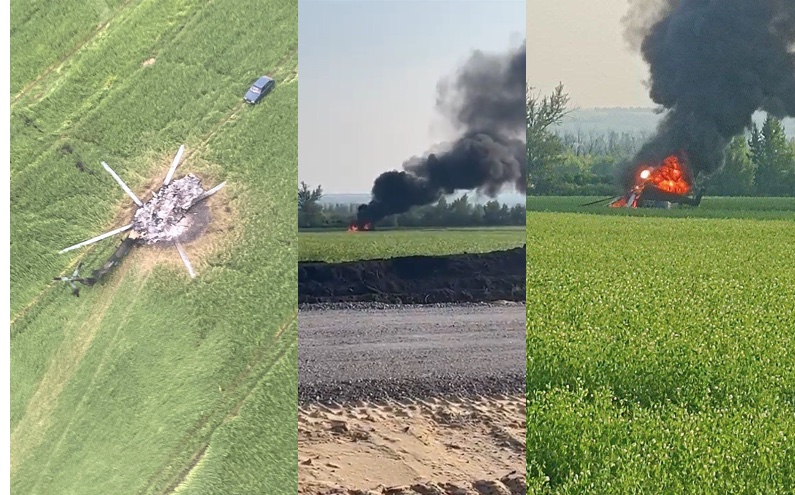
Banner: Screenshots allegedly showing Mi-8MTPR downed in Voronezh. (Source: @nexta_tv/archive, left; @zarrar_11PK/archive, center; @UAWeapons/archive, right)
To mark the six-month anniversary of Yevgeny Prigozhin’s failed mutiny against the Russian Ministry of Defense (MoD), the DFRLab revisited open-source footage published during the weekend of June 23, 2023, to document equipment losses resulting from the insurrection. Using geolocation techniques while leveraging pre-existing work from across the open-source community, we analyzed available open-source evidence of the fighting that took place with MoD forces. Based on this analysis, we estimate that the mutiny resulted in at least RUB 440 million in equipment damage – approximately $16.5 million at the time of the rebellion. In addition, the DFRLab also re-examined false or misleading claims that gained traction on the internet during the mutiny.
The mutiny began on June 23, when Prigozhin posted a Telegram video following an alleged attack against a Wagner base in Ukraine. In it, he targeted Russian defense ministry leadership and blamed them for initiating Russia’s invasion of Ukraine. Within hours, Prigozhin launched his mutiny, which he framed as “the March of Justice.”
In the early hours of June 24, Wagner soldiers crossed the Ukraine-Russia border into Rostov Oblast before continuing onward to Voronezh Oblast. The open-source community collected footage of Wagner columns moving along the M-4 “Don” highway in the direction of the Russian capital, as well as Prigozhin’s own videos documenting his overtaking of Russia’s Southern Military District headquarters in Rostov-on-Don.
Russian President Vladimir Putin, while urgently addressing the nation during the uprising, declared that the mutiny’s march was “treason” and that “actions in defense of our motherland will be harsh.” While Prigozhin’s tanks entered Rostov with little resistance, the Russian government declared a counterterrorism alert throughout the regions in which Wagner ventured. Police commandeered civilian vehicles in an effort to erect barricades and block Wagner’s advance, and both sides exchanged fire in several locations.
By the time Prigozhin declared an end to the mutiny, nearly a dozen Russian air force pilots had perished; the military would later honor them posthumously as war heroes. Similarly, President Putin also decorated local law enforcement officials in Rostov, saying they “indeed stopped a civil war.”
Two months after the mutiny, Prigozhin died when his private jet exploded mid-air and crashed north of Moscow.
Verifying the damage and destruction
Social media users posted footage showing helicopter and airplane crashes during the mutiny. The DFRLab used available open-source information to geolocate and verify the downed aircraft, as well as estimate their financial value.
Ilyushin IL-22 transport aircraft
On June 24, reports emerged that Wagner had shot down an Antonov An-24 (NATO designation “Coke”) transport aircraft. Later, Telegram channels posted footage of the wreckage, clearly showing the registration number as belonging to an Ilyhushin IL-22M bomber.
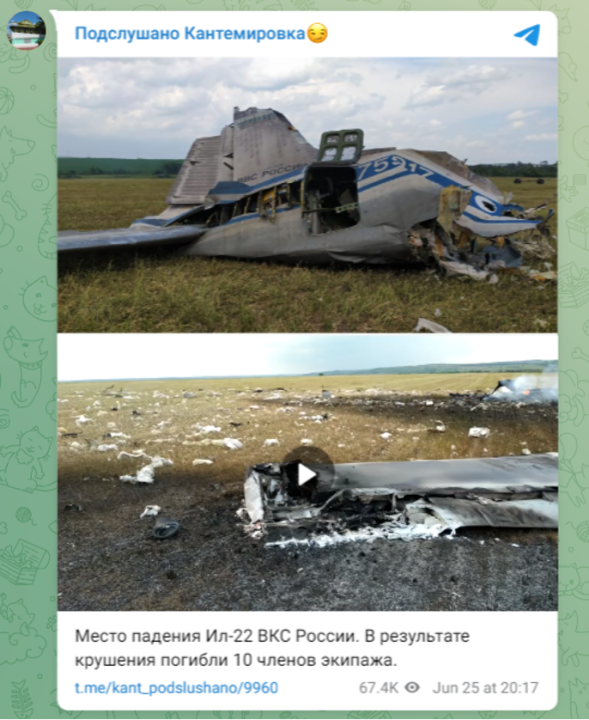
The footage showed an aircraft identified as IL-22M-11 with the registration number RF-75917 being shot down in Kantemirovka, Voronezh Oblast. Several Twitter accounts geolocated the footage, and volunteer researchers on community-based geolocating platform GeoConfirmed also verified the location.
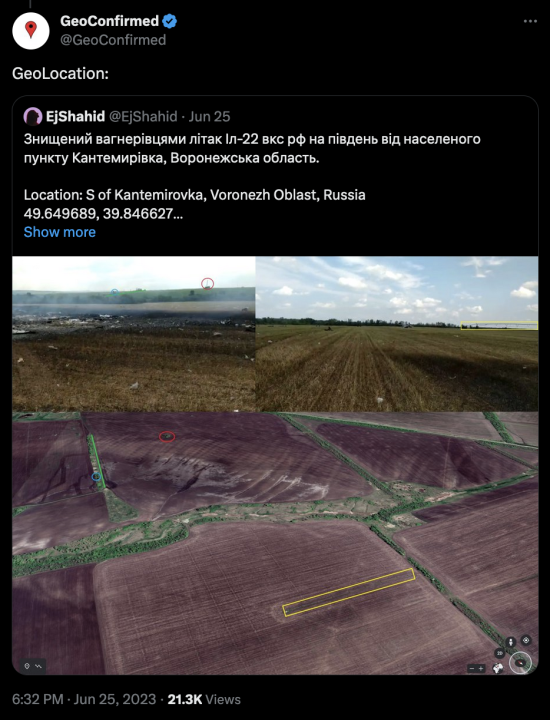
The DFRLab analyzed web archive records of russianplanes.net, a website that collects data regarding Russian planes. As some pages of the live website are currently inaccessible, archive records from June 25 provided an alternative means of checking the status of IL-22 RF-75917, which had been updated as “catastrophe (there are casualties)” alongside an Mi-8AMT (Mi-171) helicopter.

Russian sources published the names of ten crew members of the downed IL-22 killed during the incident. Also, Telegram channels claimed that Prigozhin had agreed to pay “50 million” – currency unknown – to the families of the pilots.

The Ilyushin IL-22M (NATO designation “Coot-B”) was designed as an airborne command post and based on the earlier IL-18D model. According to available open sources, Russia had fewer than twenty IL-22M aircraft. In 2022, Ukrainian forces damaged one of the IL-22s. According to online reports, the estimated cost of modernizing the Il-22M11 aircraft is between 310 to 330 million RUB, equivalent to approximately $3,444,540 to $3,666,300 USD.
Kamov Ka-52 attack helicopter
On June 24, videos from multiple angles emerged online indicating that Wagner had shot down one of Russia’s Ka-52 attack helicopters. Some social media accounts claimed that the same Ka-52 had bombed an oil depot in Voronezh Oblast.
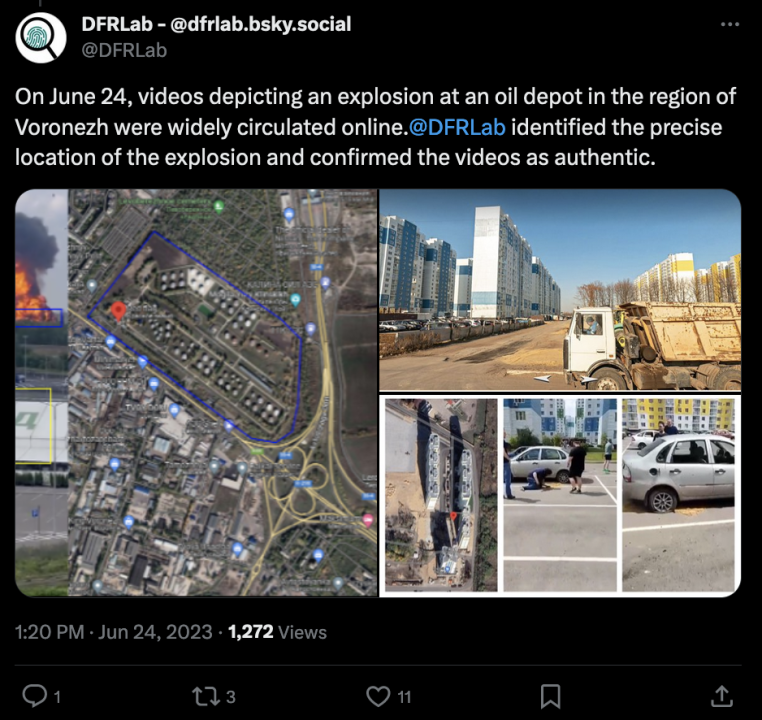
Footage of the Ka-52 shared online showed at least six angles prior to Wagner shooting it down. One of the videos showed a Ka-52 flying in Voronezh and fired on by Wagner. Twitter user @ConflictsW geolocated the footage, which the DFRLab subsequently corroborated.

The DFRLab geolocated another video showing an engagement between an MoD Ka-52 and Wagner anti-aircraft fire. In the video, the Ka-52 helicopter can be seen above a highway interchange in Voronezh.

Another video shared online showed a Ka-52 in the sky over Voronezh. One of the distinctive features of Ka-52 is coaxial rotor design with two counter-rotating rotors stacked on top of each other. By comparing video with another Ka-52 photo taken by Reuters, it was possible to identify the model of the helicopter.

Later footage showed a Ka-52 shot down by Wagner in Voronezh. Pro-Kremlin Telegram channel Демилитаризация БД (“demilitarization DB”) reported that two crew members had been killed. The DFRLab confirmed that the helicopter was a yellow 72 Ka-52 with the registration number RF-13418.

The Ka-52 (NATO designation “Hokum B”) is a two-seat variant of the Ka-50 single-seat attack helicopter (NATO designation “Hokum A”), as designed by the Kamov Design Bureau. In March 2022, Oryx reported that Russia had lost thirty-eight Ka-52 helicopters during the invasion of Ukraine. According to the 2022 edition of the Military Balance, the International Institute for Strategic Studies annual journal assessing military capabilities and defense economics, Russia initially possessed 133 Ka-52s. In 2021, the Russian Ministry of Defense announced the price of a Ka-52 helicopter as 1 billion and 75 million rubles, which is equivalent to $11,700,418 USD as of July 13.
A video and photos, along with several reports, depicted another downed helicopter, suggesting that one Mi-8, one Mi-35, and three Mi-8MTPR helicopters had been downed in the villages of Elizavetovka (in the Pavlovsky region) and Filonovo (in the Boguchansky region), both in Voronezh Oblast. The DFRLab, however, was unable to independently verify these claims.

Documenting the destruction of equipment along the M-4 highway
The M-4 highway connects the southern regions of Rostov and Voronezh to Moscow. As Prighozin launched his “March of Justice,” footage posted online indicated that Wagner military columns faced resistance both from law enforcement agencies as well as civilian equipment deployed to block the mutineer’s progression toward the capital.
Attack against an alleged Wagner civilian vehicle column by the Russian Army
Footage posted by Russian media outlet BAZA allegedly showed Russian military aircraft bombing a roadway in Voronezh Oblast. Although the DFRLab could not confirm this independently, opposition media outlets attributed the attack to the Russian air force. The video showed at least six destroyed Kamaz 5490-S5 trucks. These were alleged to be part of a Wagner column of civilian trucks en route to Moscow via Voronezh Oblast.
Looking at the original video uploaded to TikTok by the account @user6911394960374, three Russian UAZ 452 military vehicles appear to lead the column of Kamaz trucks.


The DFRLab confirmed the location of the incident to be on a secondary road north of the village of Bugayevka in Voronezh Oblast. Bugayevka is next to the border of the so-called Luhansk Peoples’ Republic in eastern Ukraine, from which Wagner forces had entered Russian territory.

Russian opposition media outlet Important Stories analyzed additional footage from the same area, this time including more specificity that a burnt KAMAZ 5490-S5 truck had the registration plate Н541НК750. Internet users also uploaded footage of burnt vehicle debris in which the registration plate is still visible. According to the Important Stories report, the KAMAZ 5490-S5 truck was produced in 2016 and had belonged to the company X5 Retail Group until 2017. The suffix 750 in the registration number indicates that the vehicle was registered in Moscow Oblast.

The company later declared to Important Stories that it had sold the vehicle in August 2022, a change not reflected in Russia’s public registry of vehicles and plates. In another press comment published by online Russian-speaking newspaper Novaya Gazeta, the company reportedly posted a copy of the sale document, highlighting a company called Truck-Stock had bought the vehicle on August 25, 2022.
According to Russian car sales portal Avito, a KAMAZ 5490-S5 truck would cost a little under RUB 6 million, around $65,000 USD. Only one vehicle seems to have been destroyed in the incident.
Civilian trucks used as obstacles
On June 24, a video emerged on social media showing how three civilian trucks, posing as obstacles, fell over either side of a bridge on the M-4 motorway seventy kilometers south of Voronezh.

The DFRLab independently confirmed the location of the incident as happening over the Ikorets River. The three trucks appeared to be KAMAZ 65115, which local authorities deployed to prevent the advance of Wagner’s military column into the oblast, according to Russia news outlet Gazeta, quoting the man speaking in the video.
Another video posted to Twitter showed a police officer in the Moscow region saying that law enforcement was “taking the keys” of KAMAZ 65115 trucks to barricade the M-4 road in the area of Lipetsk. According to information posted on the website of the Russian company TEKHNIKOM, which produces KAMAZ vehicles, new KAMAZ 65115 units cost around 5,970,000 rubles each (around $65,000 USD).
Wagner-operated Ural-4320 debris south of Voronezh
Information posted by Russian state media agency TASS contained footage of a destroyed Ural-4320 6×6 all-purpose vehicle. These have been used by the Russian armed forces and irregular militias since the beginning of the 2022 invasion of Ukraine.

Utilizing video footage posted on Telegram, the DFRLab confirmed the location of the incident. The Ural-4320 truck seemed to have been struck twenty-seven kilometers south of Voronezh on the M-4 highway.

Estimates differ regarding the price of the Ural-4320. According to car sales portal Avito, an older 2007 model could cost around RUB 1.6 million (about $17,000 USD) whereas a newer 2021 model would cost around RUB 7.6 million (roughly $80,000 USD).
Wagner KAMAZ 5350 destroyed by Russian Ka-52 at the entrance of Voronezh
On June 24, a video surfaced showing the destruction of an alleged Wagner KAMAZ 5350 as it entered the city of Voronezh on the M-4 highway. According to the original post, the truck had allegedly been hit by one of the Russian Army’s Ka-52 helicopters, but there was no evidence within the video to corroborate this claim.

The DFRLab confirmed the location of the incident, using a video posted by open-source research Telegram channel “War In Ukraine. Technical losses,” which identified the equipment.
The video of the destruction of Wagner’s KAMAZ 5350 truck also showed yellow buildings in the background, which the DFRLab identified at the time as a residential area shelled on June 24.
According to postings on Avito, prices for KAMAZ-5350 start at around RUB 3 million, or around $30,000 USD.
Wagner’s movements in Rostov
On the night of June 23, several videos posted to social media indicated that Rosgvardia (Russia’s National Guard) troops had moved into the city of Rostov. For example, one video showed troops passing Astor Gallery and Keks café, both of which are located on Budonnovskiy Prospekt, Rostov-on-Don, near the MoD’s Southern Military District headquarters.
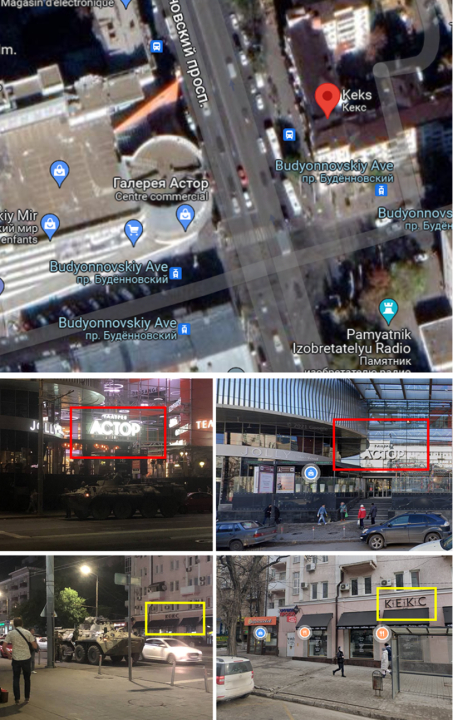

As footage depicting roadblocks emerged online, the BBC reported at 11:40 p.m. Moscow time that Rosgvardia had positioned roadblocks on the M-4 highway. According to the BBC, a source claimed that unspecified Russian officials had given orders to open fire “in case of a threat.” In the same period, the open-source community posted traffic data showing traffic on the M-4 highway of Rostov, a result of the Russian government’s moves to slow or halt Wagner’s advance.
On June 24 at 5:00 a.m. Moscow time, another video posted online claimed to show Wagner troops passing by MoD personnel without any deterrence or interference. The DFRLab geolocated that video to have been filmed near a Metan gas station in Rostov.
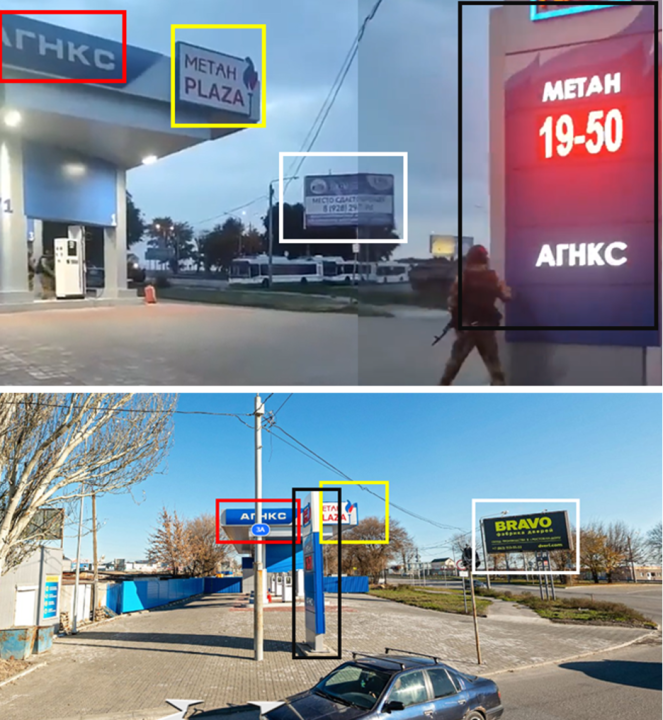
That same morning, additional videos released online showed Wagner in Rostov. Some footage taken on Budonnovskiy Prospekt showed inhabitants arguing with Wagner troops; these were posted by pro-Kremlin sources on Telegram. However, there were other videos showing inhabitants supporting Wagner.
Footage circulating that morning showed Wagner soldiers in the streets of Rostov, moving outside of MoD’s Southern Military District headquarters.
Another video from Rostov showed interaction between Wagner soldiers and civilians. The video showed Wagner soldiers searching a civilian car emblazoned with a Z – which became symbol of support for Russian forces early in Russia’s war on Ukraine – and disarming its driver. The video was taken in front of a Sberbank branch on Budonnovskiy Prospekt, near to MoD’s Southern Military District headquarters in Rostov. Some accounts claimed that they were Akhmat soldiers – members of Russia’s 141st Specialized Motor Regiment comprised of Chechen soldiers but nicknamed after Chechen leader Ramzan Kadyrov – but the DFRLab could not verify those claims.

Meanwhile, a video released online allegedly offered additional evidence that Chechen soldiers had supposedly arrived in Rostov. By searching “Tabak 24,” which can be seen on a sign in the video near to Budonnovskiy Prospekt, the DFRLab was able to geolocate the video to have been filmed near the MoD’s Southern Military District headquarters.
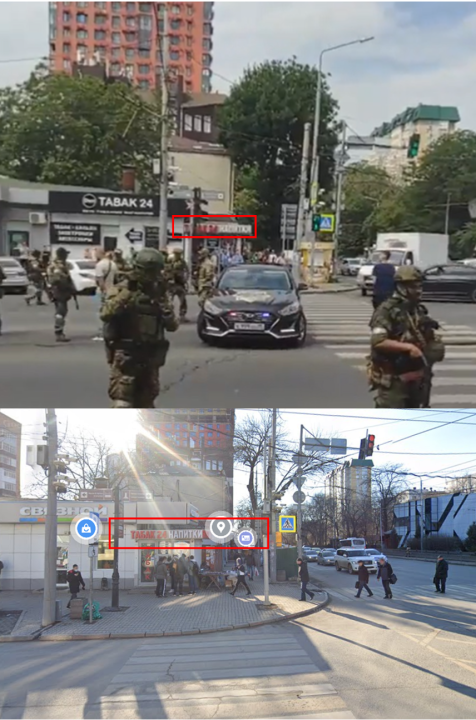
Sorting out rumors from reality
On the day the mutiny broke out, Wagner soldiers proceeded to drive military columns along the M-4 highway through the Voronezh and Rostov Oblasts located in Western Russia, along the Ukrainian border. Accompanying their advance was a swirl of rumors about their progress, with several social media posts circulating old or fabricated footage.
Alleged missile strike on Wagner camp by the Russian MoD
On June 22, at 11:04 p.m. Moscow time, Wagner-affiliated Telegram channel the Reverse Side of the Metal posted a video from an alleged Wagner camp, visited and filmed by Aleksandr Simonov. Simonov is a Russian war correspondent who frequently posts about Wagner on his personal Telegram channel. In the video, Simonov talks with masked Wagner soldiers, as they show off their camp site and their exercises.
A day later, on June 23 at 8:59 p.m. Moscow time, another Wagner-affiliated Telegram channel posted a video allegedly showing a Russian MoD missile attack on the Wagner camp. A minute later, Prigozhin reposted a video in which he declared the Russian MoD to be responsible for the alleged attack. At 9:09 p.m., his angry statement appeared on another Wagner-affiliated Telegram channel, saying “a huge number of fighters were killed.” And at 9:25 p.m., a new audio recording of Prigozhin appeared online in which he declared war against the MoD.
Open-source investigative outlet Bellingcat published an investigation comparing Simonov’s video with the video posted by the Wagner-affiliated channel. As with Bellingcat, the DFRLab could not locate the specific geographical location where the alleged missile attack occurred, but by comparing footage posted by Russian military blogger Simonov against Prigozhin’s video of the aftermath of the alleged missile attack, the DFRLab was able to corroborate Bellingcat’s conclusion that the location shown in the video was the same as that of the alleged attack.
In the video of the alleged missile attack, one of the scenes shows a Wagner soldier running in panic on a wooded path. The same path appeared in Simonov’s video at a point at which, after leaving a bunker, he also walks down the same path.

A normal video showing the aftermath of a missile attack would be expected to show extensive visible damage, including scattered debris, destroyed bunkers, wounded soldiers, active fires, or smoldering ruins. In the alleged aftermath video, there is one corpse, a small area with several damaged trees, and two small fires. The timing of Simonov’s visit, Prigozhin’s usage of an alleged attack video to declare war on his own country, and a lack of reliable sources to confirm his assertions all thrown some doubt as to the level of veracity of his claims.
Unsupported allegations that Wagner gained access to Voronezh-45 nuclear base
In June 24 Telegram post, the Free Russia Legion, a group of pro-Ukrainian and anti-Putin Russian soldiers, claimed that Wagner soldiers had gained access to “tactical nuclear weapons.” The Free Russia Legion supported its claim with a video clip showing the bombing of the Anna-Brodovoye bridge between the cities of Borisoglebsk and the village of Anna in Voronezh Oblast. The Free Russia Legion alleged the bombing of the bridge aimed to cut the road leading to the closed military city of Voronezh-45, which is home to military unit 14254. The unit is a part of the 12th chief directorate of the Russian MoD and is responsible for tactical nuclear weapons.
According to the allegations posted by the Free Russia Legion, Wagner mutineers drove around twenty light armored vehicles and temporarily took control of the facilities of Voronezh-45. The Free Russia Legion estimated around two hundred Wagner soldiers could have taken part in the operation. Vladimir Osechkin, founder of investigative project Gulagu.net, posted to Telegram on June 25 that soldiers from military unit 14524 might have also participated in the mutiny.
The DFRLab attempted to verify these claims using social media data and video forensics, starting with geolocating the video shared by the Free Russian Legion on Telegram. The original video showed a round of four airborne projectiles hitting the dirt junction on the northern side of the bridge.

By comparing the footage with street-level captures on Yandex Maps, the DFRLab identified the location of the bridge in Voronezh Oblast.
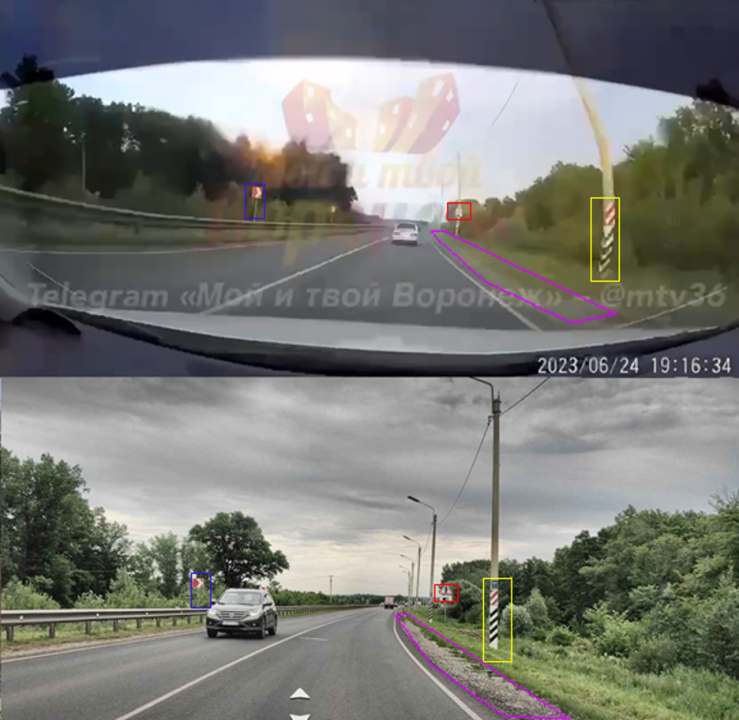
A post by opposition Telegram channel Astra claimed that no Wagner soldiers were in the area at the time of the attack, but three civilians had been injured. Local Russian outlet Ria Glas-Media quoted the governor of the oblast, who indicated that the people injured in the attack had been compensated with RUB 100,000 (approximately $1,100) each. Another local news outlet, Bloknot, also posted an account of the bridge’s partial destruction, supplemented with photos of the aftermath. Telegram footage complemented the news reporting, as eyewitnesses uploaded their own videos and photos.

Bloknot also reported that the bridge was located at the entrance of the village of Brodovoye, near Anna. Russian Telegram channel Baza posted additional footage that showed the extent of the damage on the upper side of the bridge and a fence. This destruction was observable in satellite imagery that captured the collapsed northern side of the road.
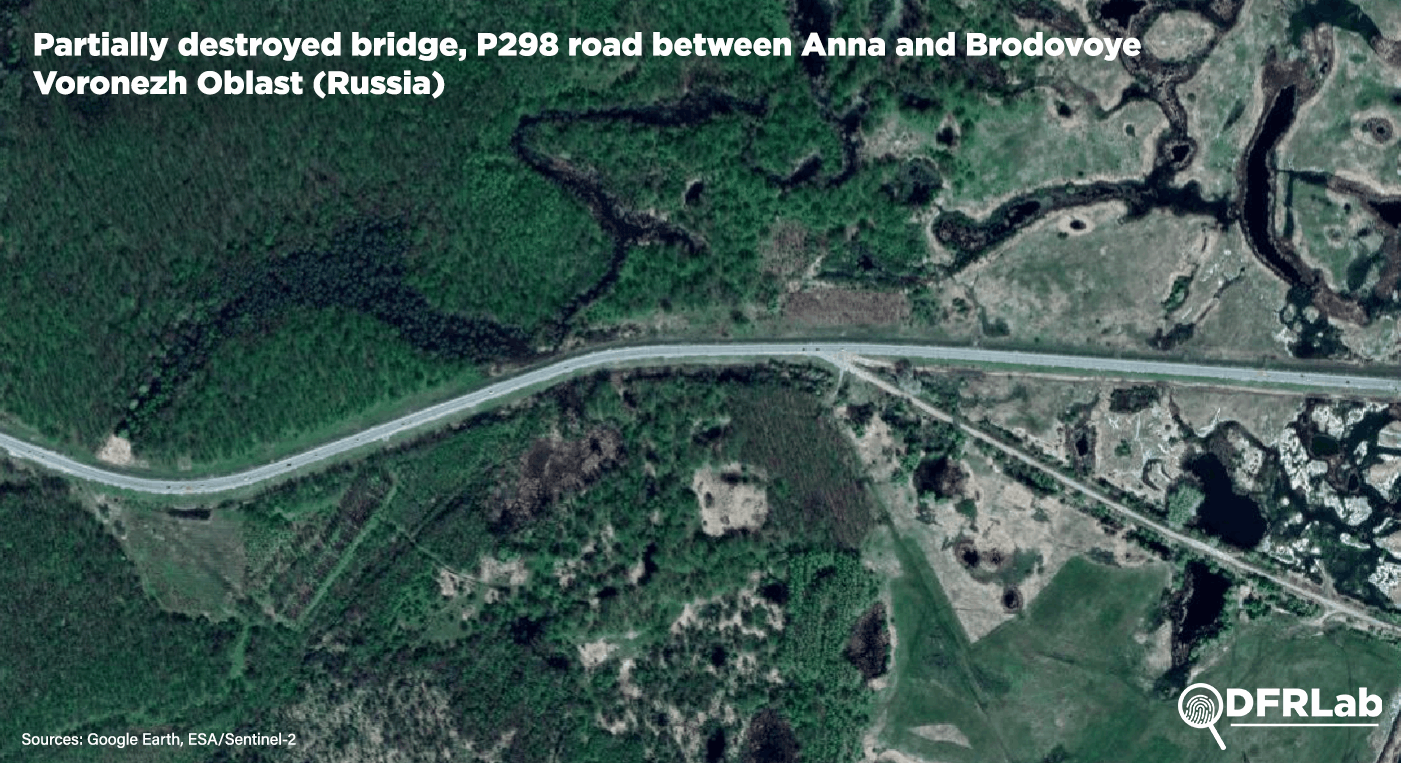
Despite the claims made by the Russia Free Legion, no footage ever emerged that would have confirmed that Wagner personnel were in the immediate vicinity of Voronezh-45. The circumstantial evidence brought forward by the Russia Free Legion did not depict the closed military city and indicated Wagner used an alternative route to potentially join other Wagner forces located in Lipetsk or Tambov Oblasts. In the absence of footage from Voronezh-45 base itself, there is no evidence to substantiate claims that Wagner entered Voronezh-45, let alone that it commandeered tactical nuclear weapons.
Viral photo incorrectly portrayed as aftermath of Russian National Guard mistakenly firing on civilian car
On June 24, videos and photos using older images from a 2014 incident went viral after some social media accounts claimed that they reportedly showed how the Russian National Guard had fired on a civilian vehicle during the mutiny.
The videos and reports relied on eyewitness reports released online that suggested that the Russian MoD had used FAB-500 bombs to destroy a bridge serving as a junction between the M-4 highway and regional road located two kilometers away from the town of Bogucha in Voronezh Oblast. Following these claims, a photo circulated on different platforms in English, Turkish, and Arabic in which the Russian National Guard had allegedly mistakenly fired on a civilian car in Bogucha. According to the posts, the Russian National Guard had killed a man and injured his wife and their daughter. The posts were shared on Twitter and Instagram at least thirty times and, at the time of research, had received more than 10,000 likes.

Using TinEye, an image-verification tool that can identify the oldest version of visuals, and Google Images, the DFRLab found the true provenance of the photo. Despite the claims during Prigozhin’s mutiny, the photo actually originated in reports around a 2014 incident in Ukraine. According to Ukrainian media’s coverage of the 2014 event, ahead of parliamentary elections, a car had been fired upon near the District Election Commission No. 33 in the city of Kryvyi Rih. Reports said the car belonged to Konstantin Usov, a candidate for the parliament at the time. Media stated that two people were injured. A photo of the car from another angle could also be seen in the earlier media reports.

These claims were also debunked by Arabic fact-checking platform Misbar.
Arma 3 video game footage posted as a supposed engagement between MoD and Wagner
During the Wagner mutiny, four Twitter accounts – @pintumandalAITC, @AGCast4, @ChetnaRaja, and @Twitermytweet – posted one of two different videos with highly similar text; in each post, the account claimed that the Russian military and Wagner had exchanged fire. A number of separate debunks and verifications subsequently appeared online – including from the broader Twitter community, fact-checkers from DW, and IFCN approved fact-checking organizations the Quint, Boom, Factly, Newscheeker – all of which determined that the footage was in fact from the video game Arma 3.
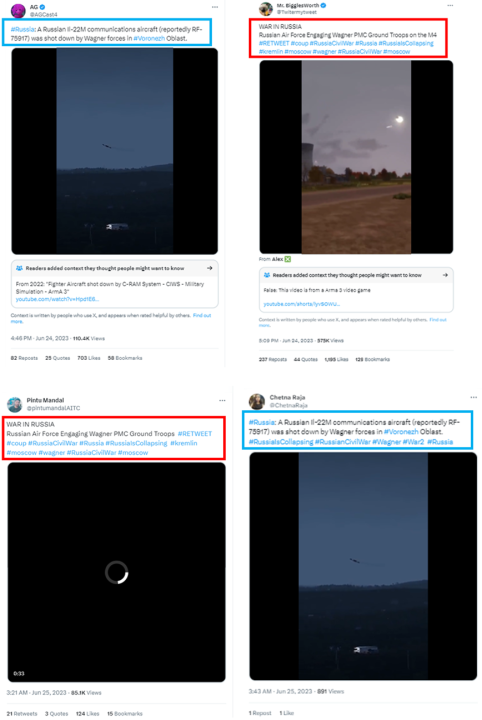
The posts received more than 2,000 interactions combined. Both videos, however, were taken from Arma 3, a video game developed by Bohemia Interactive.
Arma 3 is a realistic combat game, featuring realistic weapons, terrain, and water environments. In recent years, fact-checkers have debunked dozens of Arma 3 videos that have been falsely connected to wars and conflicts beyond Russia’s current war on Ukraine, including in Syria, Afghanistan, and the second Karabakh war.
Tallying the equipment losses and their value
Open-source footage of the mutiny preserved visual documentary evidence of the fighting between the Russian army and Wagner units. Through geolocation and verification, this footage allows researchers to establish a more detailed timeline of the mutiny, map the progression of Wagner, and calculate a baseline of equipment losses.

The DFRLab’s cost estimations are founded on publicly available postings relating to the equipment identified in available footage. As such, it constitutes a conservative estimate of equipment losses over the course of the June 2023 mutiny.
Cite this case study:
Sayyara Mammadova and Valentin Châtelet, “Documenting equipment losses from the 2023 Wagner mutiny,” Digital Forensic Research Lab (DFRLab), December 21, 2023, https://dfrlab.org/2023/12/21/documenting-equipment-losses-from-the-2023-wagner-mutiny.

